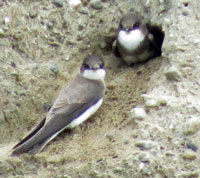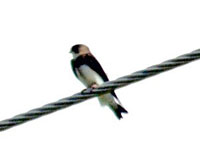Bank Swallow
Scientific name: Riparia riparia


Cover photo credits: © Charlotte Bill CC BY-NC (left) and © Jaliya CC BY-NC (right)
Status
Threatened
Threatened
means the species lives in the wild in Ontario, is not endangered, but is likely to become endangered if steps are not taken to address factors threatening it.
Date added to the Species at Risk in Ontario List
June 27, 2014
Read the assessment report (PDF)
What it looks like
The bank swallow is a small songbird with brown upperparts, white underparts and a distinctive dark breast band. It averages 12 cm long and weighs between 10 and 18 grams. Males and females are similar in size and colour.
This swallow can be distinguished in flight from other swallows by its quick, erratic wing beats and its almost constant buzzy, chattering vocalizations.
Bank swallows eat insects, feeding singly, in pairs, or in flocks. They catch flying insects in the air, though they will also eat land and water-based insects or spiders when there are many available.
Where it lives
Bank swallows nest in burrows in natural and human-made settings where there are vertical faces in silt and sand deposits. Many nests are on banks of rivers and lakes, but they are also found in active sand and gravel pits or former ones where the banks remain suitable. The birds breed in colonies ranging from several to a few thousand pairs.
The bank swallow migrates south for the winter, primarily to South America.
Where it’s been found in Ontario
The bank swallow is found all across southern Ontario, with sparser populations scattered across northern Ontario. The largest populations are found along the Lake Erie and Lake Ontario shorelines, and the Saugeen River (which flows into Lake Huron).
Although still widespread in Ontario, the bank swallow has declined in numbers and locations where it is found in the province.
View a larger version of this map (PDF)
What threatens it
A number of factors taken together are believed to threaten the bank swallow. These include loss of breeding and foraging habitat, destruction of nesting habitat, widespread pesticide use (that has reduced the populations of insects they eat), impacts of climate change and collision with vehicles.
Although activities at sand and gravel pits may contribute to the loss of some nests, the fact that a large number of bank swallow colonies in Ontario are located in sand and gravel pits suggests they also provide important nesting habitat.
Action we are taking
Threatened species and their general habitat are automatically protected.
Recovery strategy
A recovery strategy advises the ministry on ways to ensure healthy numbers of the species return to Ontario.
Read the executive summary and full document (June 2, 2016)
Government response statement
A government response statement outlines the actions the government intends to take or support to help recover the species.
Read the government response statement (March 2, 2017)
Review of progress
A review of progress made toward protecting and recovering a species is required no later than the time specified in the species’ government response statement, or not later than five years after the government response statement is published if no time is specified.
Read the report on progress towards the protection and recovery of 12 species at risk, including Bank Swallow (2022).
Habitat protection
General habitat descriptions are technical, science-based documents that provide greater clarity on the area of habitat protected for a species.
Read the general habitat description for the Bank Swallow (July 2015).
What you can do
Report a sighting
Report a sighting of an endangered animal or plant to the Natural Heritage Information Centre. Photographs with specific locations or mapping coordinates are always helpful.
Learn more about reporting wildlife.
Volunteer
- Volunteer with your local nature club or provincial park to participate in surveys or stewardship work focused on species at risk.
Be a good steward
- Private land owners have a very important role to play in species recovery. You may be eligible for stewardship programs that support the protection and recovery of species at risk and their habitats.
- Birds Canada is working to advance the understanding, appreciation and conservation of wild birds and their habitat in Ontario and elsewhere.
- The Canada-Ontario Farm Stewardship Program is available to farmers registered under the Canada-Ontario Environmental Farm Plan to encourage greater protection and conservation of habitat for species at risk.
- As with all wildlife, don’t disturb or harass the birds or nesting sites. Be respectful and observe from a distance.
Report illegal activity
- Report any illegal activity related to plants and wildlife to
1-8766-MOE-TIPS (663-8477) .
For more on how you can help, visit Birds Canada.
Quick facts
- At Long Point, Ontario, inner bay cattail marshes are used as night-time roosting sites by many bank swallows as they fly south for the winter.
- The bank swallow is found on every continent except Antarctica and Australia.
- The bank swallow is the smallest swallow in the Americas.
- Male bank swallows can dig a 60-90 cm long burrow in four or five days. Males and females then construct a nest of grasses, feathers, rootlets and leaves in which the females typically lay four or five eggs.
